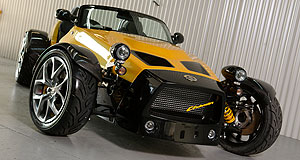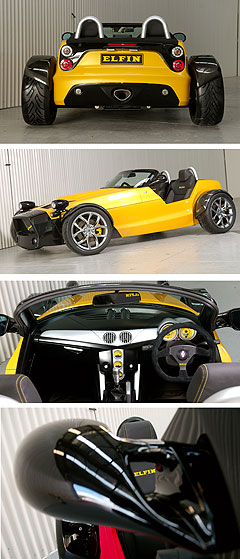First drive: New Elfin Type 5 eyes Brit clubbers
BY JAMES STANFORD | 8th Dec 2008

Now owned by Tom Walkinshaw, the iconic Australian motorsport marque has added a new four-cylinder model predominantly aimed at English clubman customers.
It hopes the new car will see its sales surge past 100 a year - a massive increase given the outfit has produced just 45 cars since production started in late 2006.
The Elfin Type 5 Clubman will be sold alongside the MS8 V8 models that failed to connect with English drivers and were panned by the local press.
While the hairy-chested MS8s have the benefit of brute force, they can also be quite a handful to drive. The T5 Elfin is not only lighter, but a lot of work has gone onto making it a benign handler.
It won't be cheap, with the base car starting off at $64,950 and a list of options that could push the price closer to $80,000.
The T5 is the successor of the Type 3 Elfin, which was introduced in 1998 but dated back to the 1960s. The T3 used different versions of Toyota's high-revving 4AGE 1.6-litre four-cylinder, which could also be supercharged, but this engine's compliance finally ran out at the end of 2006.
Instead of simply finding another engine, Elfin decided to build a new car from the ground up with a lighter and more rigid new frame, new suspension and a range of components, including brakes, differentials, axles, steering rack and column sourced from the VE Commodore.

Believe it or not, this relatively advanced compact four came out of General Motors in North America, where it powers the Pontiac Solstice and Saturn Sky.
It produces 194kW at 5300rpm and 351Nm of torque from 2500rpm through to 5300rpm.
A non-turbo engine 2.4-litre four, which might be more suitable for some racers wishing to participate in naturally-aspirated classes, is likely to be added to the Elfin stable in future.
The boosted engine is available with a five-speed manual transmission driving the rear wheels only. An automatic is not available.
There is no official 0-100km/h time, but the Type 5 is expected to do the sprint in less than four seconds.
No traction control or electronic stability control is available, and nor is an anti-skid braking system.
Elfin says that most of its customers are not so concerned about these kinds of driving aids, but admits the costs involved in developing the systems meant it was not an option for such a low-volume vehicle.
No airbags are available for the Type 5, but it can be optioned with a bolt-on steel CAMS-approved rollcage.
The Type 5 uses a new laser-cut multi-tubular space frame that comprises a lot more round tubing than the V8 Elfins, which only use square tube.
It has double wishbone suspension all round using Koni adjustable dampers and Eibach springs. Cast Elfin uprights are used and allow for camber adjustment at the front and back, as well as toe adjustment at the front.
The brakes run twin-piston front callipers latching onto 298mm discs at the front, while single-piston callipers with 290mm discs are used at the rear. All brake units feature braided lines.
The standard Type 5 comes standard with 16-inch alloy wheels and 205/55 tyres front and rear. Spend some extra cash and you can upgrade to 17-inch alloys with 215/45 rubber on the front and 245/40 on the rear.
HSV exterior designer Julian Quincey gave the new Elfin, which uses fibreglass panels, a distinctive look. It appears similar to the V8 models from the rear, but has a unique front-end with a modern take on the Clubman nose.
Computer Assisted Design (CAD) technology was used to design much of the Type 5 Elfin's components.
Thanks to its smaller engine, it weighs around 780kg, which is approximately 120kg lighter than the MS8 Clubman and 320kg lighter than the MS8 Streamliner.
Inside, the standard Type 5 has a flat aluminium dashboard that should appeal to racers, while an optional fibreglass and leather dashboard is available as an option.
The instrument cluster is unique to Elfin and includes a speedo, tacho, volt meter and oil pressure and fuel gauges, while the indicator and windscreen wiper stalks have been taken from the trusty VE parts bin.
Cloth seats are part of the base package, while leather trim is available as an option.
To allow for it to be registered, the Elfin comes with reflector halogen headlights but these can be replaced with an optional projector low-beam and bodycone-mounted high beam arrangement.
At the rear, the Type 5 uses the same Hella LED tail-lights as the V8 Elfins.
There is virtually no boot space in the Type 5, although there is a thin strip of space, about 15mm across and 50cm deep, behind the aluminium fuel tank underneath a clip-down cover.
While the Type 3 Elfin was offered in pieces as a kit car or as a complete "turn-key" car, the new model will only be sold fully assembled for now.
"We had the thought people wanted to buy a component car, but what we have found is that 85 per cent of the customers would love to build it, they just don't have the time," said Elfin general manager John Clark.
"We are still looking at the possibility of a component car in the future."The Type 5 can be registered under the Ultra Low Volume Scheme, which allows 25 cars to be homologated locally and 500 worldwide.
Elfin plans to sell all 25 registered cars, but is also hoping to shift 10 to 15 Type 5s that will only be for track use.
It hopes around 65 per cent of the volume will go to England, where it will be launched next April.
Mr Clark said the Type 5 was much more likely to succeed than the V8 Elfins that failed to appeal to the locals.
"We have designed this around the premise of a four-cylinder clubman so that it delivers the kind of dynamics that these people are after," he said.
"I don't think V8s are accepted too well on the UK. They (traditional clubmans) are very much a four-cylinder car," he said.
The idea of a big V8 in a light frame didn't hit the right note with English fans of clubman vehicles.
"It's not like they don't get it, it's just they are not V8 people like us," he said.